The ancient pagans worshiped idols of wood, brass, or stone. Modern society has invented an even weaker idol - clearly the most insulting of all. It is ironic that it has become fashionable to attribute the creation of this universe - and of ourselves - to randomness. "First there was nothing; then, it exploded." That's the dictum of the day.
This, of course, flies in the face of all observed phenomena as well as common sense. Whether we look through a telescope or a microscope, we are confronted with the irrefutable evidence of design : clear demonstrations of a level of skill and craftsmanship that renders any comparison with man's best efforts as clumsy and inept. Yet it has become the "politically correct" view of our society that it all just "happened" by unaided chance alone! This is what Peter refers to as "willful ignorance" ( 2 Peter 3:5).
Let's examine a "simple" leaf:
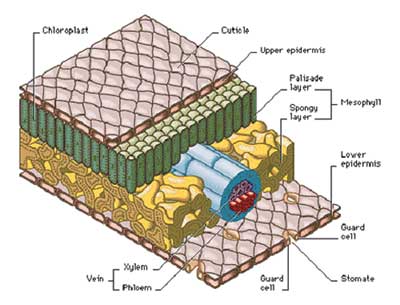
The leaf provides food for the rest of the plant through the process of photosynthesis.
The outermost layer of the leaf is the epidermis, which is protected by the waxy coating of the cuticle .
Guard cells implanted in the epidermis form pores, known as stomata , through which water, oxygen, and carbon dioxide pass.
Embedded in the inner tissues of the leaf are chloroplasts, where photosynthesis occurs. The plant veins consist of two specialized tissues: xylem conducts water from the plant to the leaf, while phloem carries food from the leaf to the plant.
The Sympathetic Miracles of Photosynthesis
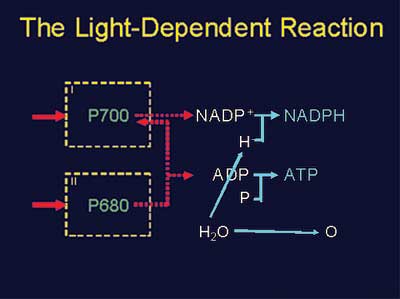 Photosynthesis is a process involving two interdependent stages: the Light-Dependent Reaction (in two phases) and the Light-Independent Reaction.
Photosynthesis is a process involving two interdependent stages: the Light-Dependent Reaction (in two phases) and the Light-Independent Reaction.
Light contains many wavelengths. Certain red and blue wavelengths of light are the most effective in photosynthesis because they have exactly the right amount of energy to energize chlorophyll electrons and boost them out of their orbits to a higher energy level.
Other accessory pigments enhance the light-absorption capacity of the leaf by capturing a broader spectrum of blue and red wavelengths, along with yellow and orange wavelengths.
None of the photosynthetic pigments absorb green light; as a result, green wavelengths are reflected, which is why plants appear green.
A chloroplast traps light energy and converts it into chemical energy contained in two types of molecules:
- Nicotinamide adenine dinucleotide phosphate (NADPH)
- Adenosine triphosphate (ATP)
 These will both be used in the subsequent Light-Independent Reaction. The Light-Independent Reaction takes the two chemicals produced in the Light-Dependent Reaction, along with CO2 , to form glucose (sugar): the NADPH provides the hydrogen atoms that help form glucose, and the ATP provides the energy for this and other reactions used to synthesize glucose in the stroma.
These will both be used in the subsequent Light-Independent Reaction. The Light-Independent Reaction takes the two chemicals produced in the Light-Dependent Reaction, along with CO2 , to form glucose (sugar): the NADPH provides the hydrogen atoms that help form glucose, and the ATP provides the energy for this and other reactions used to synthesize glucose in the stroma.
There is a broader system design that is evident in the elegance of the total picture. Plants produce both the free oxygen as well as a surplus of sugar to provide food for the animals. Animals burn this energy, producing the CO2 needed by the plants.
This highly complex interdependency all happened, of course, "simply by blind, unaided chance"! Hardly. But there is an even more astonishing insight as we stand back and behold the overall composite designs.
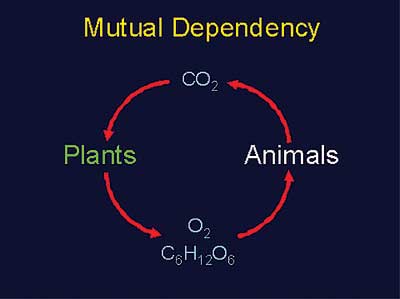 Randomness, by its very nature, lacks symmetry, or order of any kind. When scientists search the heavens with their radio telescopes searching for extraterrestrial life, they sift through the random "noise" hoping to find non-random signals indicating the presence of intelligent life.
Randomness, by its very nature, lacks symmetry, or order of any kind. When scientists search the heavens with their radio telescopes searching for extraterrestrial life, they sift through the random "noise" hoping to find non-random signals indicating the presence of intelligent life.
The very existence of non-random signals are the very evidence of intelligent life!
This is an inadvertent admission that ascribing the creation itself to randomness is a contradiction of logic. But the mathematics of nature contains many further surprises...
The Mathematics of Beauty
In 1180, an Italian mathematician named Leonardo Fibonacci discovered a strange sequence of numbers that have since attracted the attention of many perceptive observers:
1, 1, 2, 3, 5, 8, 13, 21, 34, 55, 89, 144, 233etc.
Each number is the sum of the previous two. It turns out that the ratio of any adjacent numbers approximates (1 + 5())/2 = 1.618. It would be several hundred years before these sequences would be broadly recognized in nature. In floral arrangements, the lily has 3 petals; the yellow violet, 5; delphinium, 8; mayweed, 13; aster, 21; pyrethrum, 34; helenium, 55; and the Michaelmas daisy, 89 - all Fibonacci numbers!
In the study of phyllotaxis, the spiral arrangement of leaves around a plant's stem, the leaves of the elm are arranged at 1/2 circumference; the beech and hazel, 1/3; the apricot and oak, 2/5; the pear and poplar, 3/8; the almond and pussy willow, 5/13; pines, 5/21 or 13/34; etc. In a review of 434 Angiospermae and 44 Gymnospermae, they all involve Fibonacci numbers! It turns out that this maximizes their exposure to sunlight and air without shading or crowding from other leaves.
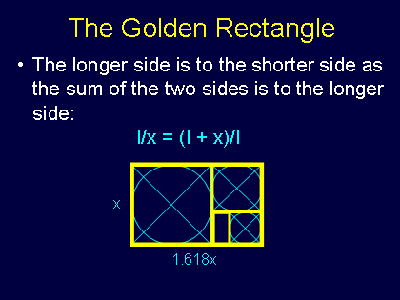 In the study of seeds, the rows of bracts on pinecones are 8 and 13; pineapples, 8, 13, and 21; etc. The optimum divergence angle of 137.5o produces the best packing. That's why you see Fibonacci spirals in the seed heads (sunflowers, etc.) But what's really astonishing is that this peculiar sequence is far more pervasive than in just botany alone.
In the study of seeds, the rows of bracts on pinecones are 8 and 13; pineapples, 8, 13, and 21; etc. The optimum divergence angle of 137.5o produces the best packing. That's why you see Fibonacci spirals in the seed heads (sunflowers, etc.) But what's really astonishing is that this peculiar sequence is far more pervasive than in just botany alone.
In art, it has long been recognized that there is a relationship known as "the Golden Rectangle". This has the peculiar property in that if you remove a square, you still retain the same "ideal" rectangle in the remainder. You find this relationship exploited in the Parthenon in Greece, the Great Pyramid in Egypt, the United Nations Building, credit cards, playing cards, postcards, light switch plates, writing pads, 3x5, 5x8 index cards, etc. In classic art, Leonardo da Vinci, Van Gogh, Vermeer, John Singer Sargent, Monet, Whistler, Renoir, Mary Cassatt, Giotto, Durer and others relied on this "golden rectangle" in their designs.
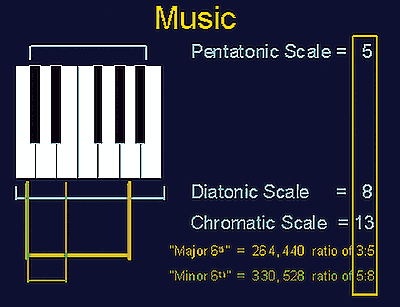 In music, the various scales are all Fibonacci numbers: most beautiful chords found in music are the major and minor sixths.
In music, the various scales are all Fibonacci numbers: most beautiful chords found in music are the major and minor sixths.
Musicians like Bach, Beethoven, Bartok, et al., would divide musical time into periods based on the same "golden" proportions to determine the beginnings and endings of themes, moods, texture, etc.
This same "Golden Rectangle" is the basis for the "Golden Spiral," which is the only spiral that does not alter its shape as it grows. This is often noticed in the chambered nautilus, but this "Golden Spiral" also appears in hurricanes, spiral seeds, ram's horns, sea-horse tails, growing fern leaves, the DNA molecule, waves breaking on the beach, tornados, galaxies, the tail of a comet around the sun, whirlpools, seed patterns of sunflowers, daisies, and dandelions; the ears of all mammals; and, the cochlea of the human ear.
What is also surprising is that even the orbits of the planets reveal a relationship suggesting the Fibonacci numbers. Penetrate into nature wherever he [the scientist] may, thought has been there before him. Clearly, the same architect that designed the plants, designed the animals, and the universe itself! His fingerprints seem to define beauty itself. God is, indeed, a mathematician.
[This summary was excerpted from our forthcoming Expositional Commentary of Genesis.]







